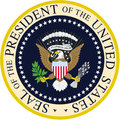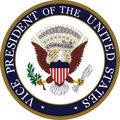Zachary Taylor
|
|
| ||||||||||||||||||||||||||
Zachary Taylor (November 24, 1784 – July 9, 1850), also known as "Old Rough and Ready," was the twelfth President of the United States, serving from 1849 to 1850. Taylor was noted for his extensive military career, becoming the first president not previously elected to any other public office. He was the second President to die in office.
| Contents |
Biography
Taylor was born in a log cabin to Richard Taylor and Sarah Strother in Barboursville, Virginia, though his family was aristocratic. As an infant he and his family moved to Kentucky, where Taylor grew up on a plantation and was known as "Little Zack."
In 1808, he joined the U.S. Army and was commissioned as a first lieutenant. Soon afterward he was ordered west into Indiana Territory, taking command of Fort Harrison. In the War of 1812 (1812–1815) he became known as an excellent military commander. Taylor was also noted for standing 5'8" or 5'9" tall and weighing between 170 and 200 pounds, with long arms, short, stubby legs and a thick torso. Taylor sometimes needed to be boosted into his saddle!
Taylor also served in the Black Hawk War (1832) and the Second Seminole War (1835–1842). During the Seminole War he gained the nickname "Old Rough and Ready" after the Battle of Lake Okeechobee.
President James K. Polk sent an army under his command to the Rio Grande in 1846. When the Mexicans attacked Taylor's troops, Taylor defeated them despite being outnumbered 4-to-1. Polk later declared war; in the Mexican-American War that followed, Taylor won additional important victories at Monterrey and Buena Vista and became a national hero.
Polk kept Taylor in northern Mexico, disturbed by his informal habits of command and his affiliation with the Whig Party. He sent an expedition under General Winfield Scott to capture Mexico City. Taylor, incensed, thought that "the battle of Buena Vista opened the road to the city of Mexico and the halls of Montezuma, that others might revel in them."
Presidency
He received the Whig nomination for President in 1848, although he had never even bothered to vote before. His homespun ways were political assets, his long military record would appeal to northerners, and his ownership of slaves would attract southern votes. He also had not previously committed himself on troublesome issues. He ran against the Democratic candidate, Lewis Cass, who favored letting the residents of territories decide for themselves whether they wanted slavery. In protest against Taylor, a slaveholder, and Cass, an advocate of "squatter sovereignty," northerners who opposed extension of slavery into territories, formed the Free Soil Party and nominated Martin Van Buren. In a close election, the Free Soilers pulled enough votes away from Cass to elect Taylor.
Zachtaylor.gif
Taylor earned a footnote in Presidential history before he even took office. His term of service was scheduled to begin at noon on March 4, 1849, but being a Sunday, Taylor refused to be sworn in until the following day. Vice President Millard Fillmore was also not sworn in on that day. As a result, it is claimed that the nation technically had no President or Vice President for one day. Some people postulate that David Rice Atchison, the previous President Pro Tempore of the Senate, was technically Acting President, but this statement is rejected by virtually every constitutional scholar. Constitutionally, Taylor's term began at noon on March 4, regardless of whether he had taken the oath or not.
Although Taylor had subscribed to Whig principles of legislative leadership, he was not inclined to be a puppet of Whig leaders in Congress. He acted at times as though he were above parties and politics. As disheveled as always, Taylor tried to run his administration in the same rule-of-thumb fashion with which he had fought Indians.
Under Taylor?s administration the Department of the Interior was organized, although the Department had been activated under President James Knox Polk?s last day in office.
Traditionally, people could decide whether they wanted slavery when they drew up new state constitutions. Therefore, to end the dispute over slavery in new areas, Taylor urged settlers in New Mexico and California to draft constitutions and apply for statehood, bypassing the territorial stage.
Zachary_taylor_stamp.JPG
Southerners were furious, since neither state constitution was likely to permit slavery; members of Congress were dismayed, since they felt the President was usurping their policy-making prerogatives. In addition, Taylor's solution ignored several acute side issues: the northern dislike of the slave market operating in the District of Columbia and the southern demands for a more stringent fugitive slave law.
In February 1850 President Taylor had held a stormy conference with southern leaders who threatened secession. He told them that if necessary to enforce the laws, he personally would lead the Army. Persons "taken in rebellion against the Union, he would hang ... with less reluctance than he had hanged deserters and spies in Mexico." He never wavered.
After participating in ceremonies at the Washington Monument on a blistering July 4, 1850, Taylor fell ill with acute indigestion and was diagnosed by his physicians with cholera morbus. He died of gastroenteritis five days later, after just 16 months in office. He is buried in Louisville, Kentucky. Taylor was succeeded by his vice president, Millard Fillmore.
Longstanding theories that Taylor had been poisoned were finally dispelled in the early 1990s when Taylor's remains were exhumed and examined [1] (http://www.ornl.gov/info/ornlreview/rev27-12/text/ansside6.html) for signs of arsenic poisoning. This forensic pathology demonstrated that Taylor was not poisoned and had probably succumbed to food contaminated with typhoid or cholera. Taylor had in fact eaten a large quantity of iced milk and cherries on the hot day prior to falling ill, one of which may have been contaminated, and which likely led to a still-extant old wives' tale stating that milk and cherries become toxic when consumed together.
Taylor's son Richard became a Confederate Lieutenant-General, while his daughter Sarah Knox Taylor married Jefferson Davis. Taylor's brother, Joseph Pannill Taylor, was a Brigadier General in the Grand Army of the Republic during the Civil War.
Cabinet
| OFFICE | NAME | TERM |
| President | Zachary Taylor | 1849–1850 |
| Vice President | Millard Fillmore | 1849–1850 |
| Secretary of State | John M. Clayton | 1849–1850 |
| Secretary of the Treasury | William Meredith | 1849–1850 |
| Secretary of War | George Crawford | 1849–1850 |
| Attorney General | Reverdy Johnson | 1849–1850 |
| Postmaster General | Jacob Collamer | 1849–1850 |
| Secretary of the Navy | William Preston | 1849–1850 |
| Secretary of the Interior | Thomas Ewing | 1849–1850 |
History Clipart and Pictures
- Pictures of the US Presidents (http://classroomclipart.com/cgi-bin/kids/imageFolio.cgi?direct=History/United_States/Presidents)
- Clipart of American Presidents (http://classroomclipart.com/cgi-bin/kids/imageFolio.cgi?direct=Clipart/American_Presidents)
- Historical Pictures of the United States (http://classroomclipart.com/cgi-bin/kids/imageFolio.cgi?direct=History/United_States)
- Pictures of the American Revolution (http://classroomclipart.com/cgi-bin/kids/imageFolio.cgi?direct=History/United_States/American_Revolution)
- Civil Rights Pictures (http://classroomclipart.com/cgi-bin/kids/imageFolio.cgi?direct=History/United_States/Civil_Rights)
- Civil War Images (http://classroomclipart.com/cgi-bin/kids/imageFolio.cgi?direct=History/United_States/Civil_War)
- Pictures of Colonial America (http://classroomclipart.com/cgi-bin/kids/imageFolio.cgi?direct=History/United_States/Colonial_America)
- Historical US Illustrations (http://classroomclipart.com/cgi-bin/kids/imageFolio.cgi?direct=History/United_States/Illustrations)
- World War II Pictures (http://classroomclipart.com/cgi-bin/kids/imageFolio.cgi?direct=History/United_States/World_War_II)
- Pictures of Historical People (http://classroomclipart.com/cgi-bin/kids/imageFolio.cgi?direct=History/United_States/People)
External links
- Zachary Taylor (http://www.whitehouse.gov/history/presidents/zt12.html)
- Zachary Taylor State of the Union Address (http://www.usa-presidents.info/union/taylor.html)
- Inaugural Address of Zachary Taylor (http://www.usa-presidents.info/inaugural/taylor.html)
References
- Bauer, Jack K. Zachary Taylor: Soldier, Planter, Statesman of the Old Southwest. Louisiana State University Press: 1993. ISBN 0807118516
- Smith, Elbert B. The Presidencies of Zachary Taylor and Millard Fillmore. University Press of Kansas: 1988. ISBN 070060362X.


